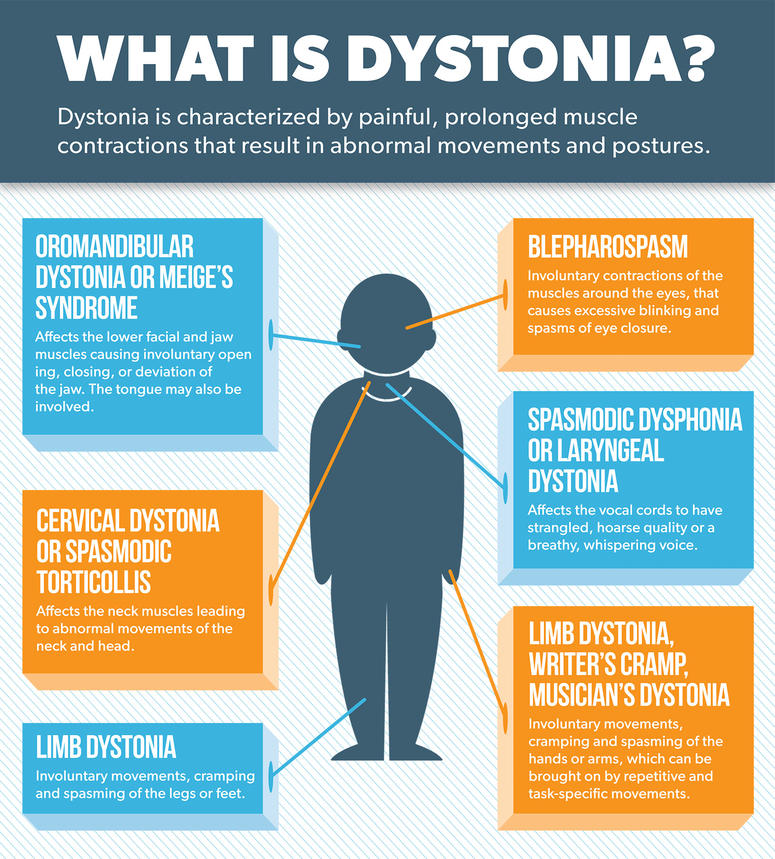The painful muscle contractions of dystonia make daily life difficult. Through an alliance with the Bachmann-Strauss Dystonia & Parkinson Foundation, our Foundation supports research to develop better treatments for the 500,000 people in North America living with dystonia.
Dystonia
Dystonia can be a symptom of Parkinson's and some other diseases and is a movement disorder on its own. Painful, prolonged muscle contractions cause abnormal movements and postures, such as a foot turning inward or the head tilting sideways. The symptoms usually begin in one body region — neck, face, vocal cords, arm or leg — and, in some cases, may spread to other parts of the body. The severity varies from person to person.
Dystonia likely involves miscommunication in the same brain region involved in other Parkinson's motor symptoms, though scientists do not yet know the exact cause. Ongoing research strives to determine the various genetic, environmental or other underlying mechanisms that may play a role in causing dystonia and to develop improved treatments.

Dystonia and Parkinson's
Some experts estimate that more than 30 percent of people living with Parkinson's disease may experience dystonia as a symptom or as a complication of treatment (dystonia can occur when levodopa is wearing off).
Dystonia is a prominent symptom for people with Parkinson's disease (PD) who have a mutation in the PRKN gene — one of a handful of Parkinson's-implicated genes — though more research is needed to understand the connection.
Types of Dystonia
Dystonia is the third most common movement disorder, affecting an estimated 500,000 adults and children in the United States and Canada. There are two main categories of dystonia: primary and secondary.
In primary dystonia, dystonia is the only clinical feature. There is no evidence of cell death or a known cause, though scientists believe there is a significant genetic contribution, even without a family history of dystonia. Among forms of primary dystonia, the most common (and the most debilitating) is generalized dystonia, which affects mainly the torso, arms and legs.
In secondary dystonia, other symptoms are also present. Some other forms of dystonia also have parkinsonism, a term used to describe the cardinal symptoms of PD: tremor, rigidity and slowness of movement. Secondary dystonia may be triggered by trauma to the head or other area of the body, drug use or exposure to rare toxins.
Secondary dystonias include:
- Myoclonus dystonia: rapid, lightning-like muscle movements; onset in childhood or adolescence
- Dopa-responsive dystonia: genetic disorder; may have features of parkinsonism or exaggerated reflex responses; childhood onset; responds to levodopa
- Rapid-onset dystonia parkinsonism: rare inherited disorder with sudden development of dystonia and parkinsonism
- Paroxysmal dystonia: sudden episodes of involuntary movements
As in Parkinson's disease, dystonia can be present in other neurological disorders, including:
- Wilson's disease: rare genetic disorder in which copper accumulates in the organs
- Huntington's disease: a hereditary, progressive neurodegenerative disorder
- Spinocerebellar ataxias: group of progressive, degenerative, inherited conditions
- Methymalonic aciduria: inherited disorder of metabolism
If you have one of the above conditions or believe you have dystonia, speak to a neurologist or movement disorder specialist for an evaluation and to discuss treatment.
Treatments
Dystonia and Parkinson's share common forms of treatment. Anticholinergic medications (such as Artane/trihexyphenidyl or Cogentin/benztropine) and levodopa may improve both conditions. (Dystonia, like other Parkinson's symptoms, can return or worsen as the effect of a levodopa dose wears off.) And deep brain stimulation is a surgical treatment for both, though the stimulation target in the brain may be different.
Other medications, such as muscle relaxants or antispasticity drugs, may also be used to treat dystonia. In addition, physicians may prescribe Botox (onabotulinumtoxinA) or Xeomin (incobotulinumtoxinA) injections, which may calm the abnormal movements for up to several months at a time.
Physical and occupational therapy may be helpful as a supplement to other therapies. Many people report beneficial effects from complementary therapies such as acupuncture and massage, although rigorous studies evaluating their efficacy are difficult.
Therapies in Development
Improvements to levodopa delivery and deep brain stimulation (DBS) for Parkinson's disease also would benefit people with dystonia. Optimizing current medications to keep levels consistent and last longer would help treat dystonia. Technologies such as "smart" DBS, which provides stimulation only when the brain needs it (rather than continuously as with current devices), may help lessen the side effects of DBS and lengthen battery life.
Scientists are studying the brain's circuitry and networks to understand more about what happens to cause dystonia. This information could help develop and direct new treatments.
Read more about Parkinson's therapies in development, including those targeting better levodopa delivery.
Learn about cutting-edge dystonia research from the winners of the annual Bachmann-Strauss Prize for Excellence in Dystonia Research. The Bachmann-Strauss Dystonia & Parkinson Foundation began with one woman's determination to make a difference in the lives of millions. Founder Bonnie Strauss now sits on the Board of Directors of The Michael J. Fox Foundation, continuing our work together to find cures for both diseases.
The medical information contained in this article is for general information purposes only. The Michael J. Fox Foundation for Parkinson's Research has a policy of refraining from advocating, endorsing or promoting any drug therapy, course of treatment, or specific company or institution. It is crucial that care and treatment decisions related to Parkinson's disease and any other medical condition be made in consultation with a physician or other qualified medical professional.